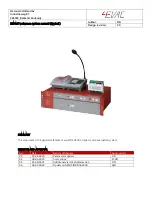
CANNON Instrument Company | Appendix II – Choosing a Temperature Bath Fluid
35
Appendix II – Choosing a Temperature Bath
Fluid
The ideal bath liquid possesses low viscosity, high heat capacity, and low vapor pressure over a wide
range of temperatures. In addition, the liquid should have a very high flash point and be relatively
low in cost. If the fluid is to be used in a kinematic viscosity bath where it is necessary to view the
instruments through the bath liquid, then it is important for the liquid to be clear and without color.
Unfortunately, no single fluid meets all these requirements.
Because no single fluid can be used at all possible bath temperatures, the choice of a suitable fluid
must begin by establishing the temperature range over which the bath will be operated. Refer to
Table 3 for a list of operating temperature ranges and some liquids suitable for use in these ranges.
Table 6: Bath Fluid Options
Temperature Range (°C)
Suitable Bath Liquids
-100 °C to 10 °C
Methyl Alcohol
-10 °C to 20 °C
Isopropyl Alcohol, Low-Viscosity Silicones
-5 °C to 60 °C
Water, Low Viscosity Oils, Silicones (Dow 200
fluid, 1 cSt)
60 °C to 100 °C
White Oils with Oxidation Inhibitor, Silicones
(Dow 200 fluid, 10 cSt)
100 °C to 200 °C
Silicones (Dow 200 fluid, 20 cSt)
135 °C to 200 °C
Silicones (Dow 200 fluid, 50 cSt)
Methyl Alcohol
Methyl alcohol is relatively volatile, has a low flash point, and has a degree of toxicity. The only
reason for using it is that there seems to be no reasonable substitute. There are some very
expensive halogen-based fluids which might be considered, but these also have a high volatility and
may be somewhat toxic.
Содержание CT-500
Страница 1: ...25 9991 Instruction Operation Manual Constant Temperature Bath CT 500 600 Series ...
Страница 2: ......
Страница 4: ......
Страница 8: ......







































